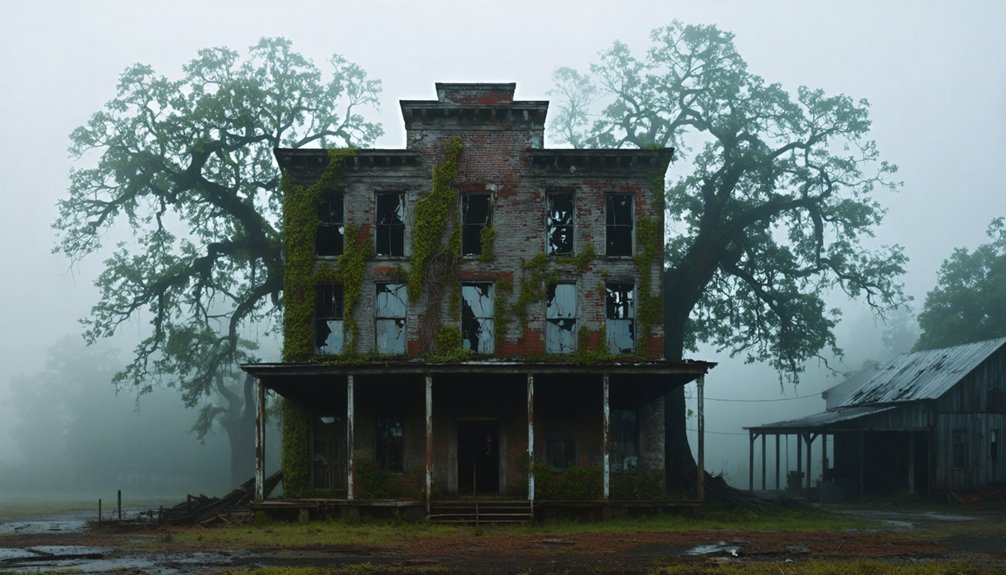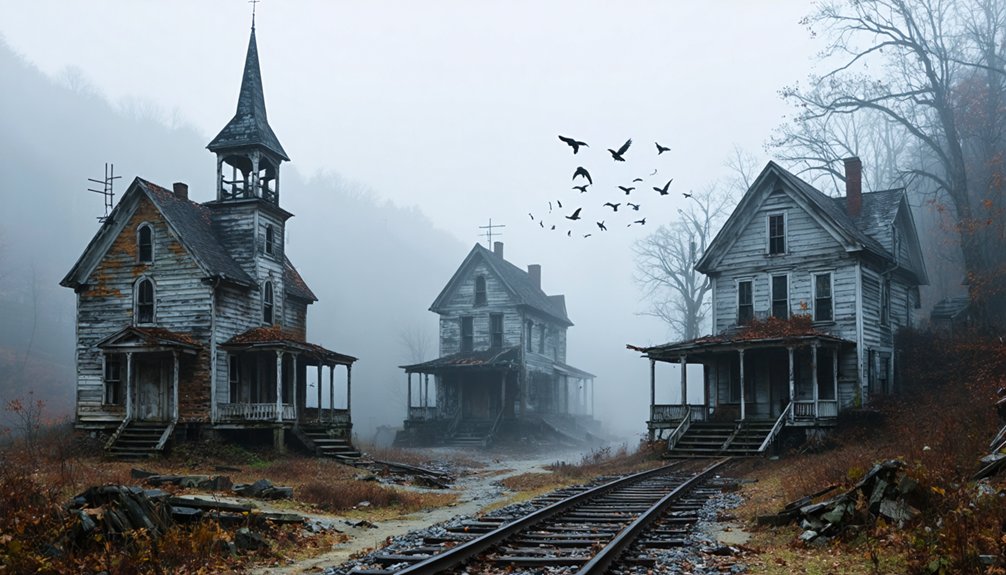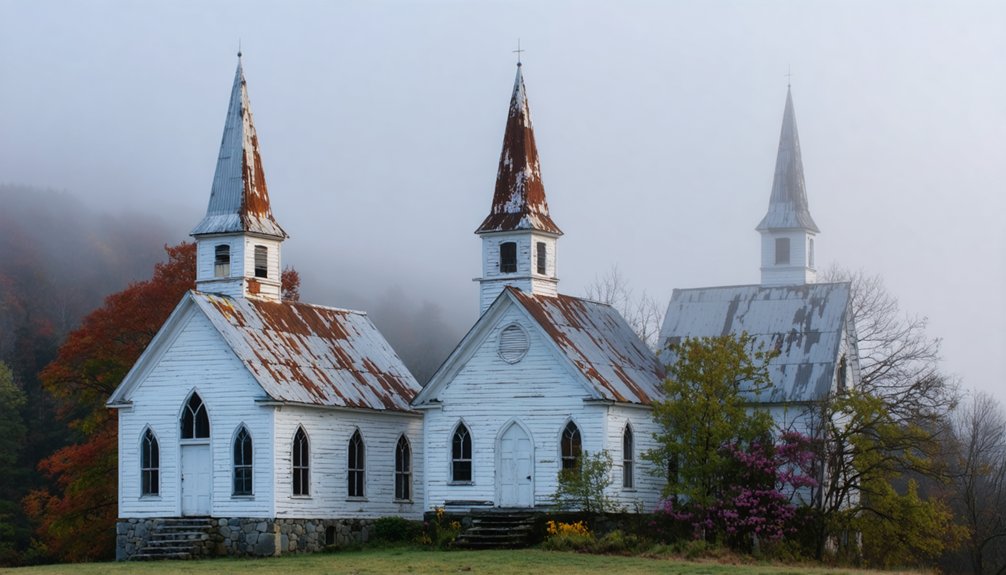In Appalachia’s ghost towns, you’ll encounter seven haunting architectural remnants: Thurmond’s abandoned coaling tower, Kaymoor’s multi-level inclined tramway, Elkmont’s weathered vacation cabins with their revealing social hierarchies, Lost Cove’s solitary stone chimneys rising from forest floors, Proctor’s submerged foundations beneath Fontana Lake, Blue Heron’s artistic metal structure outlines, and New River Gorge’s decaying 821-step wooden staircase. These silent structures tell compelling stories of prosperity, displacement, inequality, and nature’s persistent reclamation.
Key Takeaways
- Thurmond’s abandoned coaling tower and sand house represent once-thriving railroad infrastructure rendered obsolete by technological advancement.
- Kaymoor’s gated mine entrances and crumbling coke ovens showcase the remnants of a once-productive coal mining operation.
- Stone chimneys in Lost Cove stand as silent sentinels of an abandoned settlement that thrived between North Carolina and Tennessee.
- Elkmont’s weathered porches and stone chimneys symbolize social stratification between affluent visitors and temporary laborers.
- Blue Heron’s metal ghost sculptures stand on original foundations, creating an artistic representation of Kentucky’s abandoned coal mining town.
The Railroad Ruins of Thurmond: Where Time Stopped on the Tracks
How does a thriving railroad hub transform into a haunting architectural tribute to America’s industrial past?
Thurmond’s decline mirrors the fate of countless Appalachian boom towns whose fortunes were tied to a single industry.
Like silent sentinels, Appalachian ghost towns stand as cautionary tales of prosperity built on a single economic foundation.
You’ll find concrete evidence of this railroad legacy in the abandoned coaling tower and sand house—$85,000 investments from 1922 that became obsolete when diesel replaced steam.
The repair shop that once maintained engines and serviced up to 100 cars daily burned in 1993, leaving only foundations.
What’s striking is how swiftly prosperity vanished.
A town that handled more freight than Richmond and Cincinnati combined now houses just five residents.
The devastating fires of 1922 and 1930, coupled with the Great Depression and changing transportation needs, accelerated Thurmond’s transformation from crucial hub to ghost town.
The town’s rich banking history once made it home to some of the wealthiest financial institutions in West Virginia during its peak years.
The National Park Service took ownership of significant portions of the town in 1989, preserving what remains of this once-bustling economic powerhouse.
Kaymoor’s Decaying Mining Infrastructure: A Vertical Ghost Town
While Thurmond’s history unfolded along horizontal railroad tracks, Kaymoor’s ghost town tells a vertical story that’s equally compelling but structurally unique.
You’ll find this settlement split between two worlds—Kaymoor Top perched on the gorge rim and Kaymoor Bottom hugging the New River 560 feet below.
This vertically-oriented design required an ingenious inclined tramway system connecting the mining operations. Between 1899 and 1962, workers extracted over 16 million tons of coal and produced one million tons of coke before operations ceased. The single track incline transported workers and equipment over 1,000 feet downward, while a separate double track moved coal to the processing area.
Now, Kaymoor’s heritage is preserved within the New River Gorge National Park, where you can explore the gated mine entrances, crumbling coke ovens, and foundations of company houses. The remains of the once-critical coal processing facility were dismantled by government authorities in 1999 due to safety concerns.
These decaying structures stand as monuments to Kaymoor’s mining legacy—a community that once thrived across multiple elevations before being reclaimed by Appalachian wilderness.
The Silent Cabins of Elkmont: Whispers of Leisure Past
As you wander among Elkmont’s silent cabins, you’ll notice a distinct architectural hierarchy marking the social stratification that once existed between the Appalachian and Wonderland Club members.
The weathered porches sag under the weight of time, creating an eerie tableau where rocking chairs and outdoor furniture remain frozen in position as if their occupants had simply vanished mid-conversation. Originally built as part of a thriving recreational community established when Charles B. Carter founded The Wonderland Club in 1912, these structures hosted numerous social gatherings for affluent visitors. Of the original 60 structures that once populated this ghostly community, only 19 buildings were deemed suitable for restoration efforts.
Scattered throughout the ghost town, solitary stone chimneys stand like sentinels, marking where entire structures once housed the laughter of vacationing families before nature began reclaiming the abandoned resort community.
Weathered Social Hierarchies
The crumbling cabins of Elkmont tell a story far beyond architectural decay, revealing instead the calcified remains of rigid social stratification that once defined this Appalachian community.
You’ll find two distinct architectural legacies standing in silent judgment of each other: the permanent stone chimneys and substantial cottages of the Appalachian and Wonderland Clubs juxtaposed against the portable “set-off houses” of logging workers.
While Knoxville’s elite enjoyed weekend train getaways, swimming holes, and dance parties in their exclusive 115-acre paradise, laborers toiled six days weekly in temporary accommodations they couldn’t own.
The physical separation between leisure zones and working quarters wasn’t accidental—it was deliberately engineered social stratification. The Wonderland Hotel stood as the crown jewel of this resort community, highlighting the dramatic contrast between vacationers and workers.
Today, these weathered structures stand as mute testimony to a time when your position determined not just where you lived, but how. These abandoned remnants create a hauntingly beautiful escape from modern life, inviting visitors to contemplate the social divisions of the past.
Sagging Porches, Frozen Time
Nineteen silent cabins stand like timepieces frozen at their final tick, their sagging porches drooping under the weight of decades since Elkmont’s last permanent resident departed in 1992.
These architectural monuments to early 1900s Appalachian design echo the shift from industrial logging settlement to elite leisure resort.
You’ll notice the distinctive moss-covered roofs and weathered facades that tell a story of abandonment after lifetime leases expired.
The $9 million restoration project has preserved these structures using authentic materials, capturing the silent echoes of wealthy vacationers who once populated the Wonderland Club and Appalachian Club communities.
As you explore, architectural nostalgia materializes in seasonal transformations—spring wildflowers reclaiming cabin perimeters while autumn’s fiery canopy highlights structural profiles against the wilderness slowly consuming these human imprints. Visitors can find these historic structures by turning left at the Elkmont Nature Trail sign and continuing to the nearby parking lot.
Chimney Remnants Stand Watch
Towering chimneys, once the beating hearts of Elkmont’s domestic life, now stand like silent sentinels across the ghost town‘s landscape. These sturdy stone structures have outlasted their wooden counterparts, marking where the Appalachian and Wonderland Clubs once thrived during their 1912 heyday.
You’ll notice the chimney history visible in their construction—quartz chunks embedded within stonework served dual purposes as both structural elements and spiritual deterrents in local tradition. Their architectural symbolism transcends mere functionality; they represent the resilience of human creation against nature’s reclamation process.
When you explore the deteriorating cabins with their moss-covered roofs, these chimneys provide orientation points across the valley—physical landmarks of a community that once bustled with 1,500 residents before the 1934 establishment of Great Smoky Mountains National Park forever altered their destiny.
Lost Cove’s Stone Chimneys: Standing Sentinels in the Forest
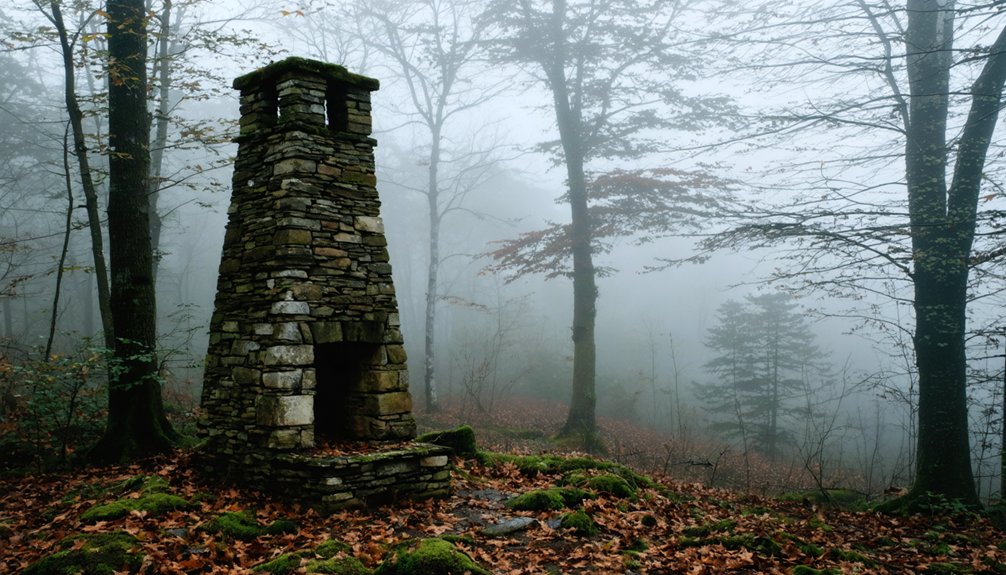
Nestled within the reclaimed wilderness of Lost Cove‘s abandoned settlement, stone chimneys rise like silent sentinels, marking where families once built their lives in this remote Appalachian enclave.
These enduring stone structures symbolize the resilience of a community that thrived between North Carolina and Tennessee from 1864 until the final exodus in 1958.
You’ll find these architectural remnants scattered across 400 acres of mountain terrain, where nature steadily reclaims what humans left behind.
Forest reclamation stories unfold around each chimney as trees and undergrowth embrace the foundations where homes once stood.
When you venture into this legendary ghost town, acquired by the Southern Appalachian Highlands Conservancy in 2012, you’re witnessing the last physical testimony of a community that flourished through timber harvesting and moonshine production before economic decline forced its abandonment. The impact of the CC & O Railway and local sawmills transformed this once-isolated settlement into a hub of economic activity, as documented in Christy Smith’s comprehensive research.
Proctor’s Submerged Shadows: Architecture Beneath the Waves
You’ll find Proctor’s architectural heritage largely concealed beneath Fontana Lake’s waters, with only the Ritter Lumber Mill and Calhoun House remaining as visible reminders of the once-thriving community.
The town’s building pattern followed typical Appalachian settlement logic—industrial structures near water sources, commercial buildings along the main thoroughfare, and residential homes scattered throughout the valley and hillsides.
When examining the submerged landscape during periods of low water, you can trace stone foundations that reveal how the community’s buildings were strategically positioned to maximize both natural resources and community interconnection.
Underwater Structural Remains
The shadowy remnants of Proctor, North Carolina lie submerged beneath the waters of Fontana Lake, offering a haunting glimpse into Appalachia’s flooded past.
When you explore these depths through underwater archaeology, you’ll discover stone and brick foundations marking where homes and businesses once stood—time capsules of early 20th-century construction techniques.
The town’s layout remains eerily intact, with clustered residential foundations, communal building remnants, and commercial structures aligned along submerged streets.
Bridge remains and dock pilings guide modern surveys of this underwater landscape. While wooden structures have largely deteriorated, the cold freshwater environment has slowed degradation of stone and masonry elements.
Sediment simultaneously protects and conceals these architectural treasures, preserving evidence of communities displaced by mid-century reservoir projects despite decades of architectural preservation challenges underwater.
Dam-Displaced Building Patterns
Beneath Fontana Lake‘s surface, Proctor represents just one chapter in Appalachia’s complex story of architectural displacement. Dam construction between the 1930s and 1960s fundamentally altered the region’s built environment, forcing thousands of families to abandon generational homes.
You’ll find scattered evidence of systematic relocation methods across multiple states. The Tennessee Valley Authority and Army Corps of Engineers orchestrated these displacements, sometimes relocating entire structures to higher ground, other times leaving communities to disperse entirely.
In cases like Jefferson, Tennessee, miscalculations in reservoir projections spared portions of towns.
Historical documentation remains in local archives—photographs, oral histories, and relocation records detailing moved churches, schools, and homes. These archives preserve the memory of communities whose physical presence has been erased by the rising waters.
Blue Heron’s Metal Ghosts: When Replicas Tell the Story
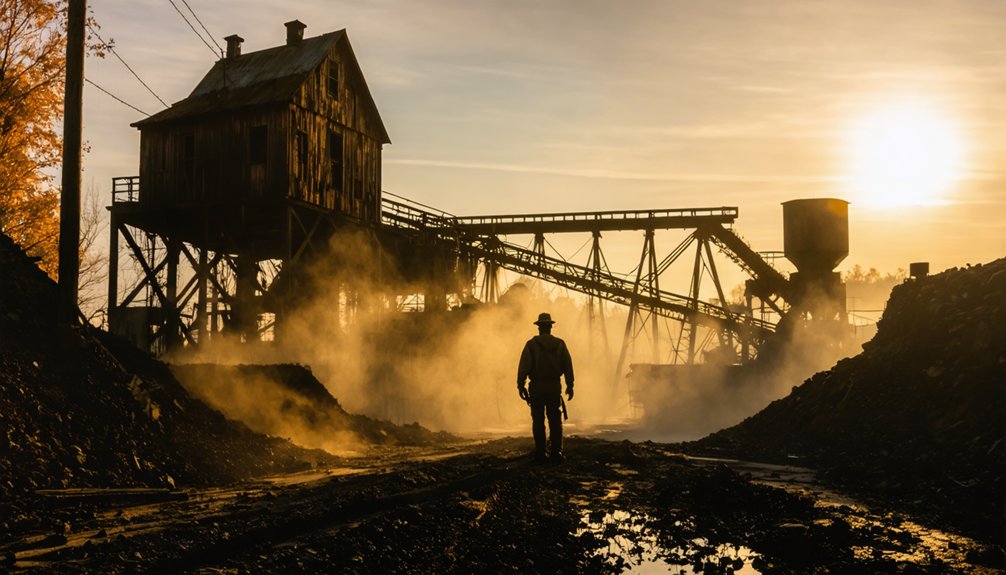
Standing eerily where original structures once thrived, Blue Heron’s metal sculptures serve as both artistic representations and educational tools that breathe life into Kentucky’s abandoned coal mining town.
As you explore the site within Big South Fork, you’ll find these weather-resistant replicas strategically positioned on original foundations, creating a ghostly overlay of what once existed.
The metal symbolism isn’t accidental—it reflects the industrial legacy and technological advancements that defined this Appalachian community.
Through artistic collaboration between historians and sculptors, these installations accurately depict the tipple, superintendent’s house, and mining equipment based on historical blueprints and photographs.
You’ll experience how these enduring metal ghosts contrast with nature’s reclamation of the landscape, offering a tangible connection to Blue Heron’s past that wooden structures, long since decayed, no longer provide.
The Vanishing Wooden Staircases of New River Gorge
Deep within West Virginia’s New River Gorge, a monumental 821-step wooden staircase gradually succumbs to nature’s reclamation, representing one of Appalachia’s most haunting industrial remnants.
You’ll find these stairs descending nearly 900 feet at a treacherous 30-degree grade, connecting the Kaymoor coal mine operations between gorge rim and river level.
Once crucial infrastructure for thousands of miners maneuvering between work sites, these wooden pathways now face critical staircase preservation challenges from weathering and vegetation.
The National Park Service has scheduled reopening for November 2025, struggling against wood’s inherent vulnerability to rot in the gorge’s humid climate.
As you contemplate these decaying switchbacks, you’re witnessing more than architecture—these steps embody the harsh conditions of mining heritage and symbolize Appalachia’s industrial rise and fall.
Frequently Asked Questions
Can Visitors Legally Collect Artifacts From These Ghost Towns?
You can’t legally collect artifacts without proper permission. Consider artifact preservation’s importance and legal implications before collecting—check site ownership status and obtain written authorization when possible.
What Paranormal Activity Has Been Reported in These Abandoned Places?
You’ll witness truly bone-chilling phenomena in these time-forgotten towns. Ghostly encounters include shadowy figures near mines, disembodied voices in churches, unexplained lights, and physical sensations tied to eerie legends like the Bell Witch.
How Do Seasonal Changes Affect Visibility of Underwater Proctor Remains?
You’ll find underwater visibility peaks during autumn’s low water levels, revealing more structures. Cold seasons improve clarity while reducing biological fouling, giving you ideal viewing conditions with fewer seasonal sediment disturbances.
Are There Restoration Plans for Any of These Deteriorating Structures?
Yes, you’ll find restoration efforts underway through AMLER funding, focusing on historically significant structures like depots and mining buildings, but they’re limited by funding disparities between rural Appalachia and urban regions.
Which Appalachian Ghost Town Has the Most Intact Architectural Features?
Like a time capsule frozen in place, Thurmond, West Virginia offers you the most intact architectural features. Its abandoned buildings retain substantial rail infrastructure, coal facilities, and residential structures of significant architectural significance.
References
- https://www.youtube.com/watch?v=4oHlJFXbrCk
- https://unusualplaces.org/elkmont-historic-district/
- https://www.youtube.com/watch?v=NFkORhmPfg0
- https://appalachian.org/lost-cove-ghost-town-in-the-national-forest/
- https://www.blueridgeoutdoors.com/go-outside/southern-ghost-towns/
- https://www.thewanderingappalachian.com/post/the-underwater-towns-of-appalachia
- https://www.youtube.com/watch?v=hKXyVRX0FQM
- https://appalachianmemories.org/2025/10/16/the-lost-towns-of-appalachia-the-forgotten-mountain-communities/
- https://www.legendsofamerica.com/thurmond-west-virginia/
- https://www.youtube.com/watch?v=ViMtkXwwKcA
